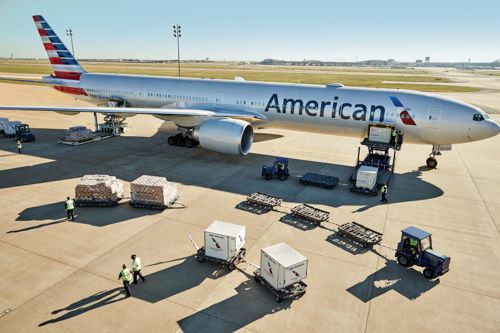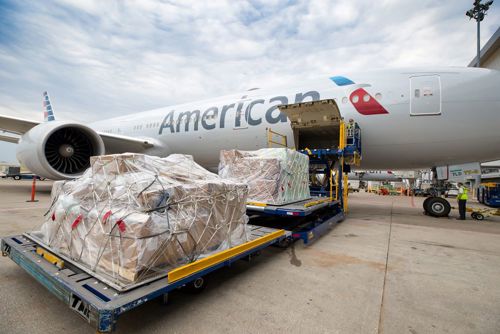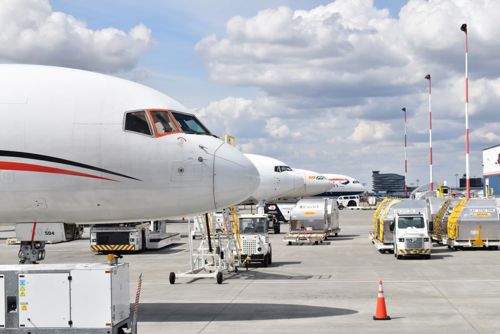
Picture copyright: Miami-Dade Aviation Department
Airlines in all major regions are experiencing a fall in global volumes, according to data from IATA, but it is less dramatic in North America than in Europe and the Middle East.
Data from other sources says that rates have fallen considerably since the start of the year but remain well above pre-pandemic levels.
At American Airlines Cargo, it has been a strong year, says Lisa Oxentine, Managing Director, Sales, with stable volumes over the summer with growth expected later in the year and in the holiday peak season in November. Some markets are softer than others, she adds, but getting back to pre-pandemic levels.
The return of passenger travel was welcomed, with Oxentine commenting, “Passenger travel has helped strengthen our network. Before the summer, American re-deployed widebody aircraft to be focused on long-haul international routes rather than domestic or short-haul international. This move was ideal for cargo, as traffic on those longer international lanes is high and we were able to take advantage of large belly capacity.”
Falling cargo demand is not a negative, American Airlines Cargo turned it into a positive.
“For us that just allows for more opportunities to say “yes” to more customers. Where we have previously had to turn down business, we can now expand our customer base and reach those we otherwise would not have been able to accommodate,” she says.
The last two years have been challenging for everyone, showing the importance of adaptability and flexibility, and modernisation was a key element.
Oxentine says, “Our modernisation journey was already underway at the start of the pandemic, but the challenges from that season only underscored the importance of having the right tools and capabilities in place to adapt to customer and industry needs quickly.”
Digitisation has been a major part, including American Airlines Cargo’s partnership with WebCargo.
Its capacity is available on WebCargo in 28 countries and in more than 40 markets in Latin America, the Caribbean and Canada.
Oxentine says, “We want to make sure we are making it as easy as possible to do business with us, and that means offering multiple options that meet varying customer needs.”
All of this puts American Airlines Cargo into a strong position heading into the peak season, with Oxentine predicting the second-best year on record.
She says, “We plan for a peak-season this fall as usual and feel well prepared to handle the business that comes our way.”

Breaking more records
Miami International Airport is forecasting another record-breaking year, says Emir Pineda, Aviation Cargo Infrastructure Development Advisor ‒ Interim at Miami-Dade Aviation Department’s Cargo Infrastructure Development Division.
2020 was a record year for Miami, which was surpassed in 2021 with 18% growth, taking airfreight up to 2.75 million tons. It is already looking good for 2022 with growth of 3.25% by the middle of the year.
Pineda says, “We are forecasting to have another record year in 2022 with strong volumes expected during the fourth quarter during the year-end high season.”
It is the perishables hub for the Americas, with 69% of all perishables, 992,546 tons in 2021, entering the US by air coming through Miami, increasing its volumes and market share.
Miami was the second airport in the world to be certified as a CEIV Pharma hub by IATA, so it was well prepared to handle the volumes of vaccines and pharmaceuticals, PPE and other related cargo during the Covid-19 pandemic.
Pineda says, “It has also helped our CEIV cargo community position itself as an excellent handling and distribution point for pharma products, which is reflected in our growth of 19.7 million kilos of pharma trade in 2021 going through MIA valued at $6.65 billion, an increase of 78.3% from 2020. This is the fourth consecutive year of over 15 million kilos of pharmaceutical cargo at MIA.”
MIA has the capacity to handle up to three million tons of cargo per annum, and having handled 2.75 million tons in 2021, with growth projected to continue, infrastructure will need to be expanded. It is forecast to hit 3.7 million tons in 2031 and 4.9 million tons in 2041.
Acquiring additional land is not easy so creative solutions are required, and that is what the Vertical Integrated Cargo Community (VICC) facility will provide.
The five-story facility will have 1.7 million square feet of cargo handling space and be capable of handling four million tons of cargo capacity when completed.
Pineda says, “VICC will advance the development of modern, high-technology new cargo infrastructure at MIA, and set a new standard for air cargo throughput efficiency, security, and resilience. The project will nearly double MIA’s cargo capacity and help the airport keep pace with forecasted growth in cargo for years to come.”

Passing one million tons
Favourable conditions means that Dallas/Fort Worth International Airport has exceeded the one million ton barrier.
John Ackerman, Executive Vice President Global Strategy and Development, says supply chain disruption, air and seaport congestion, strong demand, high sea freight rates, and the growth of e-commerce all contributed to passing the milestone.
Ackerman says, “When we increase tonnage, we increase our economic impact to the North Texas region, which is a key part of our mission. We also help make our freight forwarder gateways stronger, which enables us to further attract additional air service.”
2021 was a fantastic year, says Ackerman, though 2022 is proving more challenging, and the expectation is that volumes will be down around 5%.
Some key Asian markets were hit by Covid lockdowns, and the return of passenger services means fewer aircraft are available and capacity is being taken up by their baggage. The global challenges of high inflation, economic slowdown, and geopolitical issues have affected demand.
Ackerman says, “We believe there will be a strong push going into Q4, however we don’t think volumes will reach 2021 levels.”
Improving efficiency has been a major story for the air cargo industry. The DFW Cargo Cloud data-sharing platform was launched in March 2020, just before Covid shutdowns, so this slowed adoption but it has grown from including a few companies to nearly every ground handler in the West Cargo Area and 25 large trucking companies and freight forwarders signing up to book slots for truck appointments.
Ackerman says, “In our siloed industry, there is so much data that is not shared amongst business partners efficiently. The cargo cloud is a platform that allows information to be shared between partners who are party to the same transaction in a secure way.”
Sharing information means truckers are not making wasted journeys and when the trucker arrives, handlers can pre-stage the cargo and make the process more efficient. Slot bookings have grown from 10 a week to over 200.
Kiosks are being rolled out in handler lobbies to allow drivers to check in for appointments digitally.
Ackerman says, “We will continue to roll out future apps and enhancements to get as close to a completely digital cargo operation as possible.”
The Northwest airfield area is being redeveloped; five buildings which had reached the end of their lives and were no longer fit for purpose have been demolished.
When DFW gets the final building back off lease next year, construction will start on two buildings, 350,000 square-feet of cargo warehouse space, and seven new category VI freighter parking spaces.
Ackerman says, “We are in the process of finalising the tenants and we expect the construction to be complete in early 2024. This will effectively double our freighter capacity and set us up for our next growth phase.”
Serving the US’ fourth-largest metro area, which, with its projected population growth, is expected to be number three in 10 years’ time, this will drive demand for air cargo.
An excellent highway network means more than 250 million people can be reached in two days by truck. The Mexican border is one day away and Canada can be reached in two days.
Intermodal facilities with rail connections to major seaports makes DFW a major inland port. It is also conveniently located for connecting Asia and Latin America by air.
Ackerman says, “Our freighter network is very strong in Asia and we are working with several partner airlines to develop a freighter network to Latin America that will complement our passenger widebody service.”
Specialist cargo is key to DFW’s growth such as the cold-chain facility operated by dnata, offering the ability to handle pharmaceuticals in three different temperature zones, as well as flowers, produce and seafood. DFW was not a traditional e-commerce player but volumes exploded during the pandemic.
Later this year, DFW will be the first airport in the US with an airside Centralized Examination Station, which will be operated by dnata and staffed by U.S. Customs and Border Protection officers to rapidly inspect air imports.
This will speed up the processing of e-commerce and air shipments requiring CBP inspection, meaning e-commerce shipments can get out for final mile delivery.
DFW wants to be ready for the future, which is why it is investing heavily in its cargo facilities.
Ackerman says, “We want to ensure all of these capabilities are highlighted to the forwarders in our catchment area to make DFW the preferred gateway for our outlying cities.”

Freighter-friendly service
Activity from cargo operators surged during the pandemic at Edmonton International Airport, as they looked for a freighter friendly airport, says Mammen Tharakan, Director, E-Commerce, Cargo and Aviation Real Estate.
In 2021, a record 48,000 tonnes of cargo moved through Edmonton, up 5% on 2020 and 12.8% above the pre-pandemic baseline.
Edmonton’s cargo capabilities were key during the pandemic, supporting the movement of Covid-19 test kits, vaccines and other vital cargo.
“The increase in cargo tonnage is remarkable because passenger flights and associated belly-cargo capacity was still reduced from pre-pandemic levels,” says Tharakan.
The strong growth has continued into 2022, with volumes up 20% in the first half, and are staying high as the year continues.
Its location makes Edmonton an attractive hub, and with a land mass of more than 7,000 acres, it has room to grow cargo infrastructure well into the future.
The airport is the gateway to the Edmonton Metropolitan Region, the North, the Prairies and the Rockies, and there are over 250 businesses directly on airport land who need cargo and logistics access.
Infrastructure is being upgraded with the primary cargo apron being expanded by 47,000 square metres, providing parking for six more widebody aircraft.
Cold storage capacity is being expanded by 1,400 square metres, bringing the total to almost 2,000 square metres.
Edmonton is also the first airport in Canada to have regular drone delivery operations and is the only IATA CEIV Pharma certified airport in Canada.
In July this year, the federal government announced up to C$100m in funding from the National Trade Corridors Fund, which is available for Edmonton to enhance cargo and logistics services.
Approximately 2,000 acres of land will be converted into a new global cargo hub. The investment will expand Edmonton’s multi-modal distribution throughout Canada, the US and Mexico.
Tharakan says, “The airport’s increased cargo capacity will improve the movement of import and export trade routes and strengthen Canada’s supply chain.”
Calling the International Cargo Hub a transformational development that will be the largest cargo expansion in the airport’s history, there will be new runway connections and taxiways to integrate new cargo handling aprons with direct airside handling operations, and expansive facilities for handling, warehousing, automated e-commerce logistics and distribution.
Tharakan adds, “Consultations and engagement with our partners and communities have early construction activities, intended to kick off in 2023.”
This article was published in the October issue of Air Logistics International, click here to read the digital edition and click here to subscribe.
